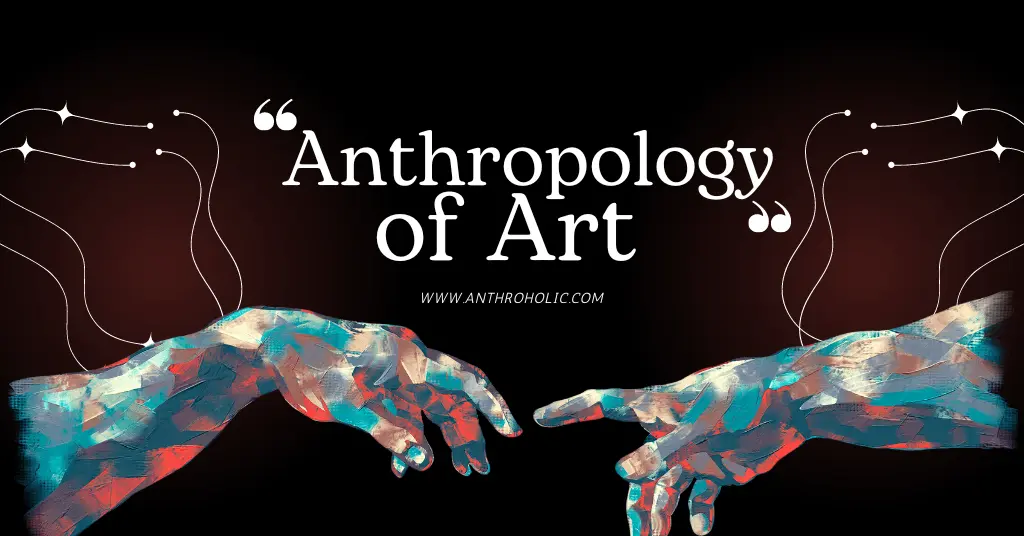AI Answer Evaluation Platform Live Now. Try Free Answer Evaluation Now
Anthropology of Art
The Anthropology of Art is a field of study that explores the rich and diverse ways in which human societies and cultures engage with artistic expression. This multidisciplinary approach allows us to gain a deeper understanding of the role of art in shaping our social, cultural, and historical experiences.

Early Development of Anthropology of Art
The Anthropology of Art as a field of study was born out of the intellectual curiosity of early anthropologists who were fascinated by the diverse artistic expressions of non-Western cultures (Layton, 1991). During the late 19th and early 20th centuries, anthropologists such as Franz Boas and Bronisław Malinowski began to document and analyze the art forms of various cultures, laying the groundwork for a more systematic study of art from an anthropological perspective.
In the mid-20th century, the field began to mature as anthropologists such as Clifford Geertz and Claude Lévi-Strauss developed new theoretical frameworks to understand the social, cultural, and symbolic dimensions of art (Morphy & Perkins, 2006). These frameworks emphasized the importance of context and meaning in the analysis of artistic expressions, leading to the emergence of various subfields such as the anthropology of visual art, performance art, and material culture.
Key Concepts in Anthropology of Art
- Symbolic Communication: One of the key concepts in the Anthropology of Art is that art serves as a means of symbolic communication, allowing individuals and communities to express their values, beliefs, and emotions (Gell, 1998). Through the study of artistic forms and practices, anthropologists can gain insights into the underlying cultural, social, and historical contexts that shape a society’s worldview.
- Cultural Relativism: Another central concept in the Anthropology of Art is cultural relativism, which emphasizes the need to understand and appreciate the artistic expressions of other cultures without imposing one’s own aesthetic judgments (Geertz, 1973). This principle has been critical in challenging ethnocentric and Eurocentric biases in the interpretation and evaluation of non-Western art forms.
- Agency and Power: The role of agency and power in the production and reception of art is another critical aspect of the Anthropology of Art. By examining the relationships between artists, patrons, and audiences, anthropologists can uncover the complex dynamics of artistic production and consumption, including issues of identity, politics, and social stratification (Morphy & Perkins, 2006).
Current Research Trends
- Globalization and Transnationalism: In recent years, the Anthropology of Art has increasingly focused on the impact of globalization and transnationalism on artistic expression and cultural identity (Marcus & Myers, 1995). This research explores the ways in which artists and cultural institutions engage with global networks, and how these interactions shape the production, circulation, and reception of art across borders.
- Digital and New Media Art: Another burgeoning area of research is the study of digital and new media art, which seeks to understand how new technologies are transforming artistic practices and the ways in which we engage with art (Gere, 2006). This research has examined the impact of digital technologies on traditional art forms, as well as the emergence of entirely new genres such as virtual reality art, net art, and interactive installations.
Conclusion
The Anthropology of Art offers a unique lens through which to explore the diverse and multifaceted expressions of human creativity. By examining the social, cultural, and historical contexts that shape artistic practices, anthropologists have shed light on the myriad ways in which art contributes to our understanding of the human experience. From its early beginnings in the study of non-Western cultures to its current focus on globalization and digital technologies, the Anthropology of Art continues to evolve and expand, offering valuable insights into the complex and ever-changing landscape of human artistic expression.
As the field continues to develop, it promises to uncover new dimensions of artistic expression and cultural identity, providing us with a richer and more nuanced understanding of the role of art in human societies. The Anthropology of Art thus serves as a vital reminder that art is not merely an aesthetic pursuit, but a deeply ingrained aspect of our shared humanity, reflecting our diverse histories, beliefs, and aspirations.
References
- Gell, A. (1998). Art and Agency: An Anthropological Theory. Oxford: Clarendon Press.
- Geertz, C. (1973). The Interpretation of Cultures. New York: Basic Books.
- Gere, C. (2006). Digital Culture. London: Reaktion Books.
- Layton, R. (1991). The Anthropology of Art. Cambridge: Cambridge University Press.
- Marcus, G., & Myers, F. (Eds.). (1995). The Traffic in Culture: Refiguring Art and Anthropology. Berkeley: University of California Press.
- Morphy, H., & Perkins, M. (Eds.). (2006). The Anthropology of Art: A Reader. Malden, MA: Blackwell Publishing.



